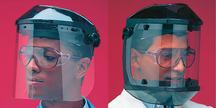
 Full face (and possibly throat) protection from splash and/or
impact is commonly required for work on or in the presence of human pathogens, some
laboratory chemicals, explosion hazards, heavy grinding and heavy spraying or splashing,
and with large (2 L and larger) quantities of dangerous liquids
such as acids, bases, and many organic liquids. A face shield can also afford extra protection
against extreme temperatures. If the faceshield is the type which has a wide opening on
the sides or bottom, and when quantities of dangerous
liquids are very large (4 L and over), protective eyewear must be worn along with
the face shield. Your work area's hazard assessment will tell you if a
face shield is
required for specific work. Full face (and possibly throat) protection from splash and/or
impact is commonly required for work on or in the presence of human pathogens, some
laboratory chemicals, explosion hazards, heavy grinding and heavy spraying or splashing,
and with large (2 L and larger) quantities of dangerous liquids
such as acids, bases, and many organic liquids. A face shield can also afford extra protection
against extreme temperatures. If the faceshield is the type which has a wide opening on
the sides or bottom, and when quantities of dangerous
liquids are very large (4 L and over), protective eyewear must be worn along with
the face shield. Your work area's hazard assessment will tell you if a
face shield is
required for specific work.
 Protection of
the face, eyes, and sometime throat by the use of a helmet or cap-like device fitted with
a clear plastic shield to resist splashing and/or impact. Throat protection is
especially necessary in the presence of chemical reaction set-ups which, because they are
large and/or potentially violent and/or of unknown nature, could deflagrate or detonate
and send glass and chemicals flying. Protection of
the face, eyes, and sometime throat by the use of a helmet or cap-like device fitted with
a clear plastic shield to resist splashing and/or impact. Throat protection is
especially necessary in the presence of chemical reaction set-ups which, because they are
large and/or potentially violent and/or of unknown nature, could deflagrate or detonate
and send glass and chemicals flying.
 Inspect
the face shield for scratches, flaws, fogginess etc., which would degrade visoin quality,
and for weaknesses, cracks, or other imperfections (such as the attachment points of the
visor to the headgear) which are out of perfect order. Replace defective equipment
before proceeding. If the headpiece is adjustable, loosen the fitting and carefully
snug it to your head so that it is comfortable and balanced, and so that the shield, when
lowered, covers adequately (full-length face shields should cover to the clavicles (collarbones), and
should completely protect the throat and neck from lacerations and punctures).
Removal (doffing) or the face shield requires no special instructions unless there
has been contamination by hazards such as radioactive, chemical, or biohazardous
materials. If this is the case, depending on the extent of the contamination, it is
usually best to remove the face shield while you are in the emergency shower, after the
contamination has been removed (or while it is being removed). Inspect
the face shield for scratches, flaws, fogginess etc., which would degrade visoin quality,
and for weaknesses, cracks, or other imperfections (such as the attachment points of the
visor to the headgear) which are out of perfect order. Replace defective equipment
before proceeding. If the headpiece is adjustable, loosen the fitting and carefully
snug it to your head so that it is comfortable and balanced, and so that the shield, when
lowered, covers adequately (full-length face shields should cover to the clavicles (collarbones), and
should completely protect the throat and neck from lacerations and punctures).
Removal (doffing) or the face shield requires no special instructions unless there
has been contamination by hazards such as radioactive, chemical, or biohazardous
materials. If this is the case, depending on the extent of the contamination, it is
usually best to remove the face shield while you are in the emergency shower, after the
contamination has been removed (or while it is being removed).
 Face shields will prevent or minimize injury from splashes and flying objects, but
depending on the potential force of a violent event they might provide enough protection.
Read the manufacturer's instructions for the shield, understand the potential for
violence of which your work might be capable, and pay careful attention to your workplace
hazard assessments and standard operating procedures. A blast shield is appropriate
between any potentially violent reaction set-up or apparatus.
Face shields will prevent or minimize injury from splashes and flying objects, but
depending on the potential force of a violent event they might provide enough protection.
Read the manufacturer's instructions for the shield, understand the potential for
violence of which your work might be capable, and pay careful attention to your workplace
hazard assessments and standard operating procedures. A blast shield is appropriate
between any potentially violent reaction set-up or apparatus.
 Manufacturer's instructions will stipulate any special considerations or
limitations, but in general your face shield will last for years if kept clean and free of
chemicals by using mild soap and water, and if stored in a protected, dry, and temperate
storage location. On most makes and models of face shields, the replacement visors
may be purchased. If protective items are not contaminated with chemical,
biological, or radioactive material, there are no special disposal considerations; they
are regular trash.
Manufacturer's instructions will stipulate any special considerations or
limitations, but in general your face shield will last for years if kept clean and free of
chemicals by using mild soap and water, and if stored in a protected, dry, and temperate
storage location. On most makes and models of face shields, the replacement visors
may be purchased. If protective items are not contaminated with chemical,
biological, or radioactive material, there are no special disposal considerations; they
are regular trash. |

